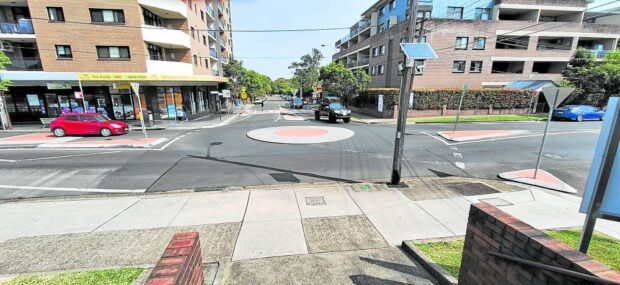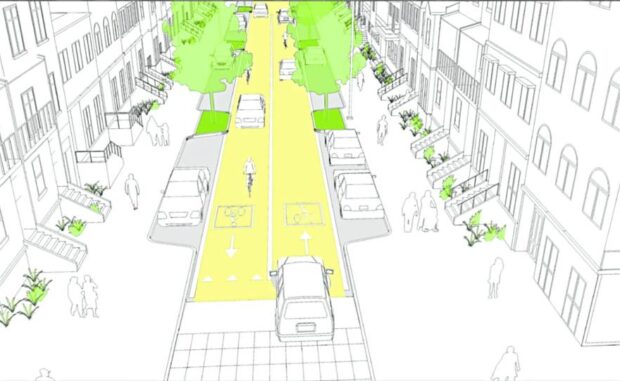How street design helps reduce road accidents

Mini roundabouts are round islands at intersections that serve to both reduce speeds and organize traffic. This is a typical roundabout in Sydney, Australia. (AMADO DE JESUS)
A few weeks ago, a road accident went viral on the Internet. It showed a car speeding into a blind intersection when a motorbike crashed into the side of the car. Due to the strong impact, the biker was thrown up in the air and over the car. The biker was seen lying on the sidewalk with a badly injured leg.
The accident could have been prevented if only both parties had taken precautions as they approached the blind corner.
According to the Philippine Statistics Authority, there were 11,096 deaths in 2021, up by 39 percent from the deaths recorded in 2011. Road traffic injuries are the leading cause of death among Filipinos 15 to 29 years old. It is also a major killer among children.
Many of these deaths occur on urban roads and are preventable accidents caused by behavior as a result of street design.
Creating safe streets
Local governments in collaboration with designers, engineers and regulators are responsible for creating safe streets. As long as street designs encourage high speeds and prioritize automobiles and other motorized vehicles over pedestrians and other vulnerable users, streets will never be able to provide safe environments.
Many traffic fatalities are linked to street design. With the addition of speed, the conditions become more dangerous.
Some common causes of traffic accidents and fatalities include:
* Sidewalks that are not usable, narrow or non-existent which force pedestrians to walk along the road exposing them to danger.
* Pedestrian crossings that are non-existent or are inadequate.
* Lack of protection: Wide, multi-lane streets without refuge spaces expose pedestrians, especially the elderly, to moving vehicles for longer distances as they cross the street.
* Large intersections that are often designed for dangerous, high-speed turning. Lack of visibility results in poor navigation and assessment of different road users’ movements.
One effective strategy to address the problem of speed which makes road conditions dangerous is by adopting what is known as traffic calming.
What is traffic calming?
Traffic calming, first developed in Germany, involves implementing design features to slow vehicles as they move through urban, commercial, and residential neighborhoods. It makes humans a priority over cars, something that runs counter to the idea that streets are made primarily for vehicles to travel on, and to get to their destination as fast as possible.
A traffic calming project is aimed at reducing and minimizing the risks posed by vehicles. It involves implementing road design features and strategies to cut down traffic speed and volume and allocate more space for pedestrians and cyclists. At lower speeds, the surroundings are more visible to the drivers and they have more time to react to unexpected events and can stop in a shorter distance.

Narrow lanes reduce speeds and minimize crashes on city streets by reducing the right of way and making drivers wary of traffic and adjacent users. (GLOBALDESIGNINGCITIES.ORG)
A traffic calming project can be something as simple as minor modifications on a specific street to a more comprehensive engineering redesign of a road network.
Traffic calming is “founded on the idea that streets should help create and preserve a sense of place, that their purpose is for people to walk, stroll, look, gaze, meet, play, shop and even work alongside cars—but not [be] dominated by them.”—Project for Public Spaces.
Examples of traffic calming strategies
Lane narrowing
Narrow lanes reduce speeds and minimize crashes on city streets by reducing the right of way and making drivers wary of traffic and adjacent users. Use the additional space for pedestrian space, cycle facilities, or green infrastructure.
Corner radius
Narrowing corner radii reduce vehicle turning speeds as well as pedestrian crossing distances. Minimizing the size of a corner radius is critical to creating safe and compact intersections.
Buildings and trees
Buildings at the right of way with articulated facades and windows indicate that a street is in an urban environment, not a highway.
Gateway treatments
Gateway treatments alert drivers that they are entering a slower area. This treatment may include signage, entry portals, speed tables, raised crossings, and curb extensions.
Mini roundabouts (or rotundas)
Mini roundabouts are round islands at intersections that serve to both reduce speeds and organize traffic, routing vehicles around the island rather than directly across the intersection.
Major considerations before traffic calming is implemented:
Is the area used by emergency, service vehicles, and school buses?
Is the area a residential, commercial, retail, entertainment, or other?
Are the users, the elderly, disabled people, and children?

Buildings at the right of way with articulated facades and windows indicate that a street is in an urban environment, not a highway. (GLOBALDESIGNINGCITIES.ORG)
Will the area be undergoing improvement?
Which roads are potential areas for the traffic calming
Many countries such as the USA, the UK, Germany, Canada, Netherlands, Sweden, Australia, New Zealand and others have planned schemes to carry out the traffic calming process.
When road accidents occur, the usual response is to blame the driver, the cyclist or the pedestrian. It is about time we realize that our roads without traffic calming features may be the silent killer that we need to focus on. It is now up to decision makers, technical experts and communities to start saving lives.
Human life is our greenest resource, right?
The author is the Principal Architect of A.P de Jesus & Associates – Green Architecture
For comments or inquiries, email amadodejesus@gmail.com
